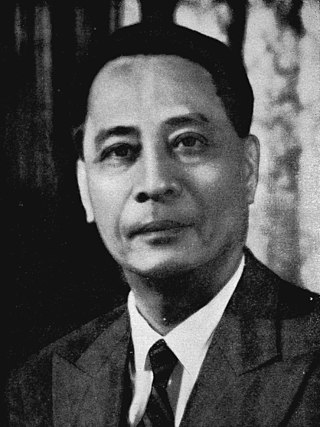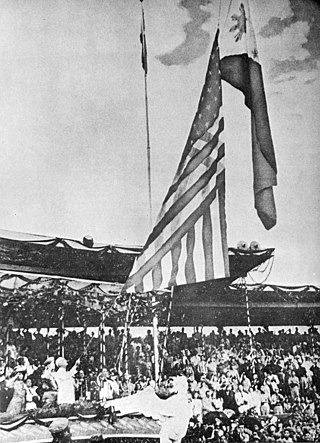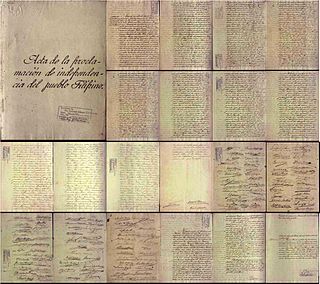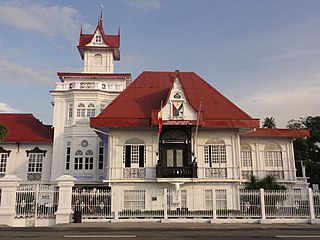
The Tydings–McDuffie Act, officially the Philippine Independence Act, is an Act of Congress that established the process for the Philippines, then an American territory, to become an independent country after a ten-year transition period. Under the act, the 1935 Constitution of the Philippines was written and the Commonwealth of the Philippines was established, with the first directly elected President of the Philippines. It also established limitations on Filipino immigration to the United States.

Emilio Aguinaldo y Famy was a Filipino revolutionary, statesman, and military leader who is the youngest president of the Philippines (1899–1901) and became the first president of the Philippines and of an Asian constitutional republic. He led the Philippine forces first against Spain in the Philippine Revolution (1896–1898), then in the Spanish–American War (1898), and finally against the United States during the Philippine–American War (1899–1901).

The Commonwealth of the Philippines was an unincorporated territory and commonwealth of the United States that existed from 1935 to 1946. It was established following the Tydings–McDuffie Act to replace the Insular Government of the Philippine Islands and was designed as a transitional administration in preparation for full Philippine independence. Its foreign affairs remained managed by the United States.

The Philippine–American War, known alternatively as the Philippine Insurrection, Filipino–American War, or Tagalog Insurgency, was fought between the First Philippine Republic and the United States from February 4, 1899, until July 2, 1902. Tensions arose after the United States annexed the Philippines under the Treaty of Paris at the conclusion of the Spanish–American War rather than acknowledging the Philippines' declaration of independence. The war can be seen as a continuation of the Philippine struggle for independence that began in 1896 with the Philippine Revolution against Spanish rule.
The governor-general of the Philippines was the title of the government executive during the colonial period of the Philippines, governed by Mexico City and Madrid (1565–1898) and the United States (1898–1946), and briefly by Great Britain (1762–1764) and Japan (1942–1945). They were also the representative of the executive of the ruling power.

Sergio Osmeña Sr. was a Filipino lawyer and politician who served as the fourth president of the Philippines from 1944 to 1946. He was vice president under Manuel L. Quezon. Upon Quezon's sudden death in 1944, Osmeña succeeded him at age 65, becoming the oldest person to assume the Philippine presidency until Rodrigo Duterte took office in 2016 at age 71. A founder of the Nacionalista Party, Osmeña was also the first Visayan to become president.

Claro Mayo Recto Jr. was a Filipino politician, statesman, lawyer, jurist, author, writer, columnist, and poet. Perhaps best known as the president of the 1934 Constitutional Convention and the Father of the 1935 Philippine Constitution, he is remembered as a fierce opponent of U.S. "neocolonialism" in Asia and for his staunch nationalist leadership throughout his career.

Manuel Acuña Roxas was a Filipino lawyer and politician who served as the fifth president of the Philippines from 1946 until his death in 1948. He served briefly as the third and last president of the Commonwealth of the Philippines from May 28, 1946, to July 4, 1946, and became the first president of the independent Third Philippine Republic after the United States ceded its sovereignty over the Philippines.

Philippine Republic Day, also known as Philippine–American Friendship Day, is a commemoration in the Philippines held annually on July 4. It was formerly an official holiday designated as Independence Day, celebrating the signing of the Treaty of Manila, which granted Philippine independence from the United States of America in 1946.

The Philippine Declaration of Independence was proclaimed by Filipino revolutionary forces general Emilio Aguinaldo on June 12, 1898, in Cavite el Viejo, Philippines. It asserted the sovereignty and independence of the Philippine islands from the 300 years of colonial rule from Spain.

Filipino nationalism refers to the establishment and support of a political identity associated with the modern nation-state of the Philippines, leading to a wide-ranging campaign for political, social, and economic freedom in the Philippines. This gradually emerged from various political and armed movements throughout most of the Spanish East Indies—but which has long been fragmented and inconsistent with contemporary definitions of such nationalism—as a consequence of more than three centuries of Spanish rule. These movements are characterized by the upsurge of anti-colonialist sentiments and ideals which peaked in the late 19th century led mostly by the ilustrado or landed, educated elites, whether peninsulares, insulares, or native (Indio). This served as the backbone of the first nationalist revolution in Asia, the Philippine Revolution of 1896. The modern concept would later be fully actualized upon the inception of a Philippine state with its contemporary borders after being granted independence by the United States by the 1946 Treaty of Manila.

The Department of Foreign Affairs is the executive department of the Philippine government tasked to contribute to the enhancement of national security, protection of the territorial integrity and national sovereignty, to participate in the national endeavor of sustaining development and enhancing the Philippines' competitive edge, to protect the rights and promote the welfare of Filipinos overseas and to mobilize them as partners in national development, to project a positive image of the Philippines, and to increase international understanding of Philippine culture for mutually-beneficial relations with other countries.

Independence Day is a national holiday in the Philippines observed annually on June 12, commemorating the declaration of Philippine independence from Spain in 1898.

The Philippine Republic, now officially remembered as the First Philippine Republic and also referred to by historians as the Malolos Republic, was established in Malolos, Bulacan during the Philippine Revolution against the Spanish Empire (1896–1898) and the Spanish–American War between Spain and the United States (1898) through the promulgation of the Malolos Constitution on January 22, 1899, succeeding the Revolutionary Government of the Philippines. It was formally established with Emilio Aguinaldo as president. It maintained governance until April 1, 1901.

The history of the Philippines from 1898 to 1946 is known as the American colonial period, and began with the outbreak of the Spanish–American War in April 1898, when the Philippines was still a colony of the Spanish East Indies, and concluded when the United States formally recognized the independence of the Republic of the Philippines on July 4, 1946.

This article covers the history of the Philippines from the recognition of independence in 1946 to the end of the presidency of Diosdado Macapagal that covered much of the Third Republic of the Philippines, which ended on January 17, 1973, with the ratification of the 1973 Constitution of the Republic of the Philippines.
The sovereignty of the Philippines refers to the status of the Philippines as an independent nation. This article covers sovereignty transitions relating to the Philippines, with particular emphasis on the passing of sovereignty from Spain to the United States in the Treaty of Paris (1898), signed on December 10, 1898, to end the Spanish–American War. US President William McKinley asserted the United States' sovereignty over the Philippines on December 21, 1898, through his Benevolent Assimilation Proclamation.

The Insular Government of the Philippine Islands was an unincorporated territory of the United States that was established in 1902 and was reorganized in 1935 in preparation for later independence. The Insular Government was preceded by the United States Military Government of the Philippine Islands and was followed by the Commonwealth of the Philippines.
The OsRox Mission (1931) was a campaign for self-government and United States recognition of the independence of the Philippines led by former House Speaker and Senator Sergio Osmeña and House Speaker Manuel Roxas. The mission secured the Hare–Hawes–Cutting Act, which was rejected by the Philippine Legislature and Manuel Quezon.

The United States Military Government of the Philippine Islands was a military government in the Philippines established by the United States on August 14, 1898, a day after the capture of Manila, with General Wesley Merritt acting as military governor. During military rule (1898–1902), the U.S. military commander governed the Philippines under the authority of the U.S. president as Commander-in-Chief of the United States Armed Forces. After the appointment of a civil Governor-General, the procedure developed that as parts of the country were pacified and placed firmly under American control, responsibility for the area would be passed to the civilian.
















